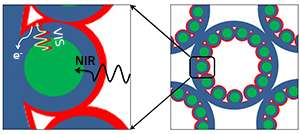Optical materials: Solar cells step up

The Sun is our most promising source of clean and renewable energy. The energy that reaches the Earth from the Sun in an hour is almost equivalent to that consumed by humans over a year. Solar cells can tap this massive source of energy by converting light into an electrical current. However, these devices still require significant improvements in efficiency before they can compete with more traditional energy sources.
Xiaogang Liu, Alfred Ling Yoong Tok and their co-workers at the A*STAR Institute of Materials Research and Engineering, the National University of Singapore and Nanyang Technological University, Singapore, have now developed a method for using nanostructures to increase the fraction of incoming light that is absorbed by a light-harvesting material. The method is ideal for use with high-efficiency solar cells.
Solar cells absorb packets of optical energy called photons and then use the photons to generate electrons. The energy of some photons from the Sun, however, is too small to create electrons in this way and so is lost. Liu, Tok and their co-workers circumvented this loss using an effect known as upconversion. In this process, two low-energy photons are combined to produce a single high-energy photon. This energetic photon can then be absorbed by the active region of the solar cell.
The researchers' device comprised a titanium oxide frame filled with a regular arrangement of air pores roughly half a micrometer across—a structure called an inverse opal (see image). Spheres of the upconversion material, which were 30 nanometers in diameter, sat on the surface of these pores. Tiny light-sensitive quantum dots made of crystals of cadmium selenide coated these nanospheres.
The quantum dots efficiently absorbed incoming light, either directly from an external source or from unconverted photons from the nanospheres, and converted it to electrons. This charge then flowed into the titanium oxide frame. "The titanium oxide inverse opal creates a continuous electron-conducting pathway and provides a large interfacial surface area to support the upconversion nanoparticles and the quantum dots," explains Liu.
Liu, Tok and the team tested the device by firing laser light at it with a wavelength of 980 nanometers, which is not normally absorbed by cadmium selenide quantum dots. As expected, they were able to measure a much higher electrical current than the same experiment performed with a device without the upconversion nanospheres. "We believe that the enhanced energy transfer and light harvesting may afford a highly competitive advantage over conventional silicon solar cells," says Liu.
More information: Su, L. T., Karuturi, S. K., Luo, J., Liu, L., Liu, X. et al. Photon upconversion in hetero-nanostructured photoanodes for enhanced near-infrared light harvesting. Advanced Materials 25, 1603–1607 (2013). dx.doi.org/10.1002/adma.201204353
Journal information: Advanced Materials



















